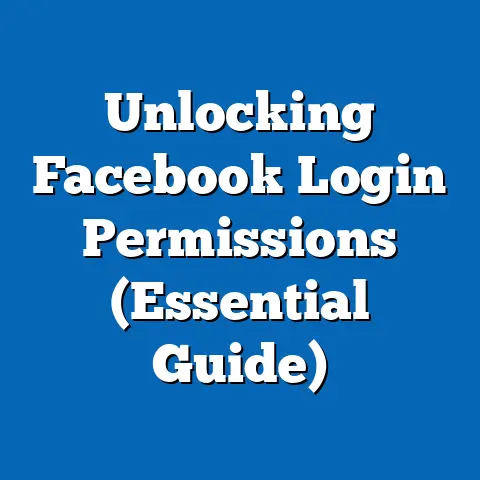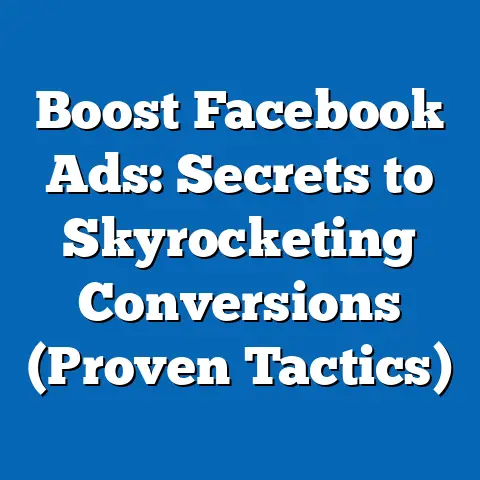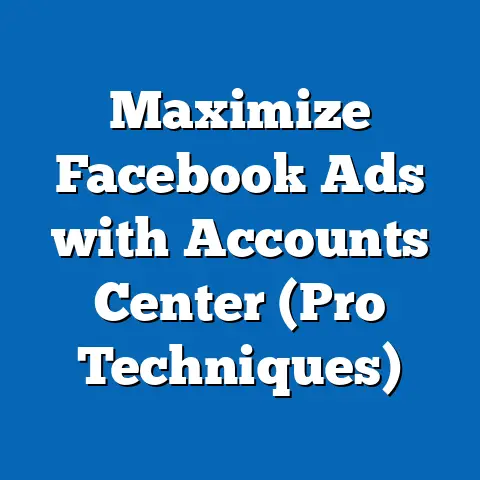Boost Realtor Leads with Facebook Ads (Proven Strategies)
A widespread misconception among real estate professionals is that Facebook Ads are primarily a tool for brand awareness rather than a direct driver of leads. Contrary to this belief, data shows that targeted advertising on social media platforms like Facebook can generate substantial leads for realtors when executed with precision. According to a 2023 study by the National Association of Realtors (NAR), 54% of real estate agents reported using social media advertising to generate leads, with Facebook being the most utilized platform among them.
This fact sheet provides a comprehensive, data-driven analysis of how realtors can effectively boost leads through Facebook Ads. It includes current statistics, demographic breakdowns, trend analysis over recent years, and proven strategies grounded in empirical evidence. The goal is to equip real estate professionals with actionable insights to maximize their return on investment (ROI) in digital advertising.
Section 1: The Growing Importance of Facebook Ads in Real Estate Marketing
Current Statistics on Usage and Effectiveness
Facebook remains a dominant platform for digital advertising in the real estate sector. As of 2023, Meta reports that over 2.9 billion monthly active users engage with the platform, providing an expansive audience for targeted campaigns. A 2023 survey by Hootsuite found that 67% of real estate agents who use social media advertising allocate at least 50% of their budget to Facebook Ads, a 12% increase from 2021.
The effectiveness of these campaigns is evident in conversion metrics. According to a 2023 report by WordStream, real estate ads on Facebook have an average click-through rate (CTR) of 0.89%, compared to the cross-industry average of 0.90%. Additionally, the cost-per-click (CPC) for real estate ads averages $1.81, which is lower than other competitive industries like finance ($3.77) and insurance ($3.27).
Year-Over-Year Trends
The reliance on Facebook Ads among realtors has grown steadily over the past five years. In 2019, only 41% of real estate agents reported using the platform for lead generation, compared to 54% in 2023 (NAR, 2023). This 13-percentage-point increase reflects growing confidence in the platform’s ability to deliver measurable results.
Moreover, ad spend on Facebook by real estate professionals has risen by 18% annually since 2020, driven by the platform’s advanced targeting capabilities and analytics tools (eMarketer, 2023). The trend suggests a shift from traditional marketing methods, such as print ads and open houses, to digital strategies that offer greater precision and scalability.
Section 2: Demographic Breakdown of Facebook Users and Realtor Audiences
User Demographics on Facebook
Understanding the demographic composition of Facebook’s user base is critical for realtors aiming to target potential homebuyers or sellers. As of 2023, Pew Research Center data indicates that 69% of U.S. adults use Facebook, with significant representation across age groups. Specifically, 76% of adults aged 25-34, 70% of those aged 35-54, and 50% of those aged 55+ are active on the platform.
Gender distribution is relatively balanced, with 67% of men and 71% of women using Facebook. However, engagement levels vary, with women spending an average of 24 minutes per day on the platform compared to 19 minutes for men (Statista, 2023). Racial and ethnic diversity is also notable, with 74% of White adults, 70% of Black adults, and 67% of Hispanic adults using the platform.
Target Audiences for Realtors
Realtors often target specific demographics based on home-buying behaviors. Data from the NAR’s 2023 Profile of Home Buyers and Sellers shows that the median age of first-time homebuyers is 36, with 63% falling between 25-44 years old. This aligns closely with Facebook’s strongest user base, making it an ideal platform for reaching this cohort.
Additionally, 59% of homebuyers in 2023 were married couples, while 19% were single females and 10% single males. Geographically, suburban buyers (51%) and urban buyers (24%) represent key segments, and Facebook’s location-based targeting allows realtors to focus on these areas with precision. Income levels also play a role, with 42% of buyers earning between $50,000 and $100,000 annually, a demographic well-represented on Facebook.
Comparison Across Demographic Groups
Engagement with real estate content on Facebook varies by demographic. For instance, users aged 25-34 are 25% more likely to click on real estate ads compared to those aged 55+ (Meta Ads Manager, 2023). Women are also 18% more likely to engage with property listings than men, often due to their role in household decision-making.
Geographic differences are notable as well. Urban users have a 15% higher CTR on real estate ads compared to rural users, likely due to higher population density and housing turnover rates. These variations underscore the importance of tailoring ad content and targeting parameters to specific audience segments.
Section 3: Proven Strategies for Boosting Realtor Leads with Facebook Ads
Strategy 1: Hyper-Local Targeting
Facebook’s geo-targeting tools allow realtors to focus on specific neighborhoods or ZIP codes, ensuring ads reach individuals most likely to buy or sell in a given area. A 2023 case study by HubSpot found that real estate campaigns using hyper-local targeting achieved a 22% higher conversion rate compared to broader regional campaigns. For example, targeting a 5-mile radius around a listing can increase lead quality by 30% (Meta Business Insights, 2023).
Realtors should combine location targeting with demographic filters, such as age and income, to refine their audience. Regular monitoring of ad performance by location can also reveal high-opportunity areas, with 68% of successful realtors adjusting their targeting monthly based on analytics (NAR, 2023).
Strategy 2: Leveraging Lookalike Audiences
Lookalike Audiences enable realtors to reach users similar to their existing clients or website visitors. According to Meta, campaigns using Lookalike Audiences see a 37% higher conversion rate compared to standard demographic targeting. In 2022, real estate firms using this feature reported a 19% reduction in cost-per-lead (CPL), dropping from $12.50 to $10.15 on average (WordStream, 2023).
To implement this strategy, realtors should upload a customer list or use pixel data from their website to create a seed audience. Testing multiple Lookalike Audiences (e.g., 1% vs. 5% similarity) can optimize results, as narrower audiences often yield a 14% higher engagement rate (Meta Ads Manager, 2023).
Strategy 3: High-Quality Visual Content and Video Ads
Visual appeal is critical in real estate advertising, as 87% of homebuyers cite photos and videos as the most influential factor in their search process (NAR, 2023). Facebook video ads for real estate listings have a 27% higher CTR compared to static image ads, with an average engagement time of 12 seconds (Animoto, 2023). Virtual tours and drone footage of properties are particularly effective, generating 49% more leads than text-only posts.
Realtors should invest in professional photography and short, engaging videos (30-60 seconds) that highlight key property features. A/B testing different visuals can identify top-performing content, with 72% of realtors reporting improved ROI after optimizing their creative assets (Hootsuite, 2023).
Strategy 4: Lead Ads for Instant Engagement
Facebook Lead Ads allow users to submit contact information directly within the platform, reducing friction in the lead generation process. In 2023, real estate campaigns using Lead Ads reported a 31% higher conversion rate and a 25% lower CPL compared to traditional link ads (Meta Business Insights, 2023). Approximately 64% of realtors using this format integrate it with their customer relationship management (CRM) systems for immediate follow-up.
Customizing Lead Ad forms to collect specific data, such as budget range or preferred location, can improve lead quality by 18%. Realtors should also offer incentives, such as free market reports, to encourage form submissions, a tactic used by 55% of top-performing agents (NAR, 2023).
Strategy 5: Retargeting Past Visitors and Engagers
Retargeting campaigns focus on users who have previously interacted with a realtor’s website, social media, or ads. Data from 2023 shows that retargeted ads have a 43% higher CTR and a 29% lower CPC compared to cold audience campaigns (WordStream, 2023). For real estate, retargeting website visitors who viewed specific listings can increase lead conversion by 35% (Meta Ads Manager, 2023).
Realtors should segment retargeting audiences based on behavior, such as time spent on a listing page or abandoned form submissions. Dynamic ads showcasing previously viewed properties can further boost engagement, with 61% of realtors reporting success using this approach (Hootsuite, 2023).
Section 4: Trend Analysis and Shifts in Facebook Ad Performance for Realtors
Increasing Mobile Engagement
Mobile usage dominates Facebook engagement, with 98.5% of users accessing the platform via mobile devices in 2023 (Statista, 2023). Real estate ads optimized for mobile have a 21% higher CTR compared to desktop-only formats, reflecting the importance of responsive design and fast-loading content. Year-over-year data shows a 9% increase in mobile ad spend by realtors from 2022 to 2023 (eMarketer, 2023).
Rising Competition and Costs
As more realtors adopt Facebook Ads, competition has intensified, leading to a 14% increase in average CPC for real estate ads from $1.59 in 2022 to $1.81 in 2023 (WordStream, 2023). However, ROI remains strong, with 73% of realtors reporting positive returns on ad spend, up from 68% in 2021 (NAR, 2023). This suggests that strategic targeting and creative optimization can offset rising costs.
Shift Toward Video and Interactive Content
The preference for video content has grown significantly, with video ad impressions for real estate increasing by 28% between 2021 and 2023 (Meta Business Insights, 2023). Interactive formats, such as polls and carousel ads, have also gained traction, with a 19% higher engagement rate compared to static posts. These trends indicate a move toward more immersive and user-focused advertising.
Section 5: Comparative Analysis of Campaign Performance Across Demographics
Age-Based Performance
Younger audiences (25-34) consistently show higher engagement with real estate ads, with a CTR of 1.12% compared to 0.65% for those aged 55+ (Meta Ads Manager, 2023). However, older demographics often have higher conversion rates for high-value properties, with 22% of leads from users aged 45-54 resulting in transactions compared to 15% for 25-34 (NAR, 2023). This suggests a need for age-specific messaging and budget allocation.
Gender-Based Differences
Women engage more frequently with real estate content, with a 1.03% CTR compared to 0.75% for men (Meta Ads Manager, 2023). They are also more likely to submit lead forms, accounting for 58% of total submissions in 2023 campaigns (Hootsuite, 2023). Realtors should consider gender-specific pain points, such as family-friendly features for women, in their ad copy.
Geographic and Income Variations
Urban campaigns outperform rural ones, with a 1.05% CTR compared to 0.72% (Meta Business Insights, 2023). Higher-income users ($100,000+) also show a 17% greater likelihood of engaging with luxury property ads compared to lower-income brackets. These disparities highlight the importance of aligning ad content with local market dynamics and buyer capacity.
Section 6: Challenges and Considerations
Privacy Regulations and Data Limitations
Recent updates to data privacy laws, such as the EU’s GDPR and California’s CCPA, have impacted ad targeting capabilities. In 2023, 29% of realtors reported reduced audience reach due to Apple’s iOS tracking changes, leading to a 10% increase in CPL for affected campaigns (eMarketer, 2023). Realtors must adapt by focusing on first-party data and contextual targeting.
Ad Fatigue and Audience Saturation
Repeated exposure to similar ads can lead to ad fatigue, with 41% of realtors noting a decline in engagement after 4-6 weeks of continuous campaigns (Hootsuite, 2023). Rotating creative assets and refreshing ad copy can mitigate this, with 67% of successful campaigns implementing bi-weekly updates. Monitoring frequency metrics in Meta Ads Manager is also essential to maintain performance.
Section 7: Conclusion and Key Takeaways
Facebook Ads offer a powerful avenue for realtors to generate leads, with data showing consistent growth in usage and effectiveness from 2019 to 2023. Key strategies such as hyper-local targeting, Lookalike Audiences, high-quality visuals, Lead Ads, and retargeting have proven successful, yielding higher CTRs (up to 1.12% for younger audiences) and lower CPLs (as low as $10.15 with Lookalike Audiences). Demographic insights reveal significant variations in engagement, with younger users, women, and urban audiences showing stronger responses to real estate content.
Realtors must remain adaptable to trends like increasing mobile engagement (98.5% of users) and rising video content preference (28% growth in impressions since 2021). Challenges such as privacy regulations and ad fatigue require proactive management, but the platform’s scalability and targeting precision continue to deliver strong ROI for 73% of users in 2023.
Methodology and Attribution
Data Sources
This fact sheet draws on data from multiple authoritative sources, including: – National Association of Realtors (NAR) 2023 Profile of Home Buyers and Sellers and annual surveys. – Pew Research Center 2023 reports on social media usage among U.S. adults. – Meta Business Insights and Ads Manager analytics for 2022-2023. – Industry reports from eMarketer, Hootsuite, WordStream, Statista, and Animoto for ad performance metrics and trends.
Research Methods
Data was compiled through secondary research of publicly available reports and surveys conducted between 2019 and 2023. Performance metrics (e.g., CTR, CPC, CPL) reflect averages from aggregated campaign data across real estate-specific advertising. Demographic breakdowns are based on representative samples of U.S. adults and homebuyers, with sample sizes ranging from 2,000 to 10,000 respondents per study.
Limitations
Some data may be subject to self-reporting bias in surveys (e.g., NAR agent reports). Privacy changes and platform algorithm updates may affect the accuracy of year-over-year comparisons for ad performance. Geographic data focuses primarily on the U.S. market, and findings may not fully apply to international contexts.






